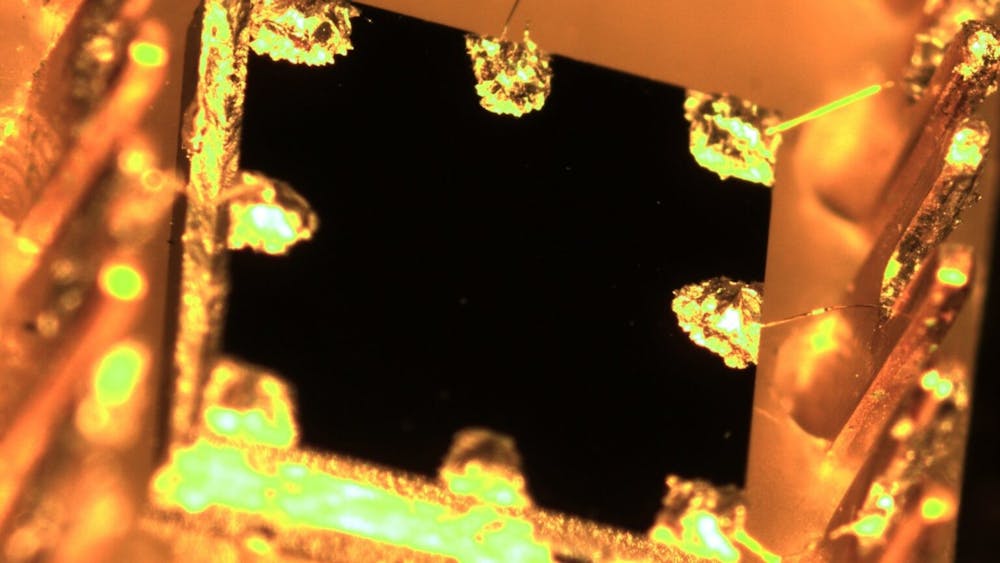Princeton researchers have created the world’s purest sample of gallium arsenide (GaAs,) a semiconductor with uses ranging from solar cells to cell phone circuits. Their work exploring quantum phenomena in low magnetic fields involves physics that has no “established theoretical framework” and has major implications for the field’s understanding of electrons.
The paper’s first authors, Kevin Villegas Rosales and Edwin Chung, both earned their doctorates in Electrical and Computer Engineering (ECE) from Princeton this year. ECE Professor Mansour Shayegan and Senior Research Scholar Loren Pfeiffer were the principal investigators.
In an email to The Daily Princetonian, Shayegan emphasized the magnitude of the achievement.
“The new samples/materials have only about 1 part per 10 billion impurities, meaning there is only one unwanted atom (impurity) for every 10 billion wanted atoms,” he wrote. “This is like having only one bad person on Earth!”
This level of purity, developed using molecular beam epitaxy — a method that deposits individual crystals in layers — exceeds that of the silicon sample used in determining the one-kilogram standard. The GaAs chip’s dimensions are comparable to that of a pencil eraser, and used by researchers to probe the nature of electrons.
“I have always been fascinated by the phenomena and phases of electrons that emerge in very ‘clean’ systems where the impurities and defects are extremely few,” Shayegan wrote.
To understand these interactions, the team wired up the sample and froze it to temperatures lower than those found in space, then surrounded it with a strong magnetic field and applied a voltage. While lowering the magnetic field, they discovered effects that have no conventional theoretical foundation.
The first effect involves Wigner crystals, phenomena in which gaseous elections form a lattice structure to minimize the effects of mutual repulsion.
Historically, physicists have believed that Wigner crystals necessitated a strong magnetic field, what Villegas Rosales describes as a field strong enough “to levitate a frog.” However, the researchers found that this crystallization was possible with much weaker fields too.
This effect is closely related to the purity of the GaAs sample.
“The ‘electron crystal’ can only be formed if the host material (gallium arsenide in our case) is extremely pure, otherwise the impurities would disturb the crystal and randomize the positions of electrons,” Shayegan added.
Additionally, the researchers studied the fractional quantum Hall effect, initially discovered by ECE professor Daniel Tsui, within the given framework. They found that their system had a larger “activation gap.”

Still the implications of Villegas Rosales’ and Chung’s research extend beyond theory.
“In a more general sense, the new samples might find use in topological quantum computing, and also as better (faster) special-purpose transistors,” Shayegan explained. “The electrons in high purity samples can move a very far distance, of the order of 1 millimeter, before hitting an impurity and going off their course. Such a ‘ballistic’ motion of electrons is desirable in fast transistors.”
These findings were published in the journal Nature Materials. The work was conceived by Chung and Pfeiffer, while Pfeiffer also designed and built the molecular beam epitaxy chamber. Other co-authors mentioned in the paper include Kirk W. Baldwin, Pranav Madathil and K. W. West, all of whom are affiliated with the University’s Electrical Engineering department.
Having completed their Ph.Ds, Vilegas Rosales is now working at a quantum computing startup while Chung remains with the two labs as a postdoctoral researcher.
Villegas Rosales and Chung did not respond to requests for comment.
Tara Agarwal is a news contributor for the ‘Prince.’ She can be reached at ta3150@princeton.edu.








